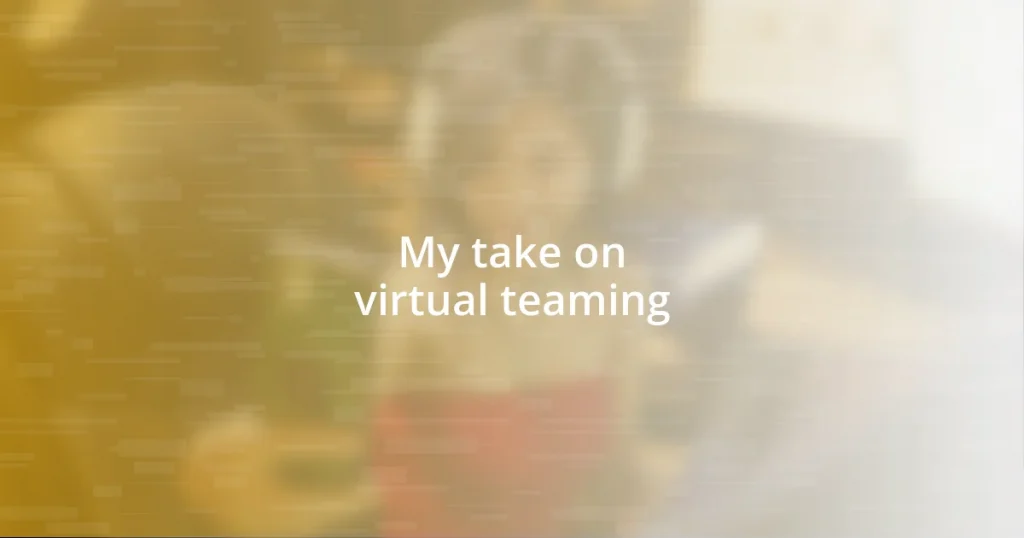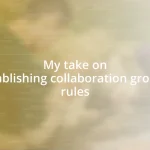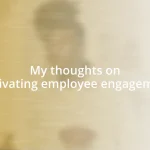Key takeaways:
- Emotional transparency and communication styles are essential for enhancing relationships and trust in virtual teams.
- Diverse virtual teams benefit from increased creativity, access to global talent, and improved productivity when leveraging collaborative tools effectively.
- Building trust online requires sharing personal stories, encouraging vulnerability, and establishing regular check-ins to foster team connection and cohesion.

Understanding virtual teaming dynamics
Understanding the dynamics of virtual teaming is crucial, especially when you consider how emotions play a role. I recall a project where our team, spread across three continents, really struggled with getting on the same page. One day, during a video call, someone shared their feelings about the isolation they felt while working remotely. That moment transformed our relationship; it made me realize how vital emotional transparency is in virtual spaces.
Another key dynamic to consider is communication styles. While some may prefer directness, others might lean towards a more nuanced approach to sharing ideas. Have you ever felt lost in a sea of messages? I remember days where I’d receive a flood of emails and chats, which left me overwhelmed and disconnected. We soon learned that establishing clear communication protocols, like regular check-ins and using shared documents, significantly helped align our goals.
Moreover, I’ve found that trust-building in virtual teams can often be overlooked. In my experience, trust isn’t built solely through work deliverables; it’s through the little moments—sharing a laugh over a mishap or celebrating small wins together. How do you cultivate trust in your teams? For me, initiating casual virtual coffee chats helped bridge gaps and foster genuine connections, making our collaboration much stronger.

Benefits of effective virtual teams
Effective virtual teams can lead to significant advantages that extend beyond just completing tasks. From my experience, having a diverse team spread across different locations fosters creativity and innovation. When I worked on a marketing project with colleagues from various backgrounds, the blend of perspectives routinely sparked ideas I hadn’t considered. This diversity not only enhanced our problem-solving capabilities, but it also made brainstorming sessions incredibly dynamic and productive.
Here are some additional benefits of effective virtual teams:
- Flexibility: Team members can work from anywhere, promoting a better work-life balance.
- Cost Efficiency: Companies can save on overhead costs like office space and utilities.
- Access to Global Talent: You can hire the best skills available, regardless of geographical limitations.
- Increased Productivity: Many find they can focus better in their home environments, leading to higher output.
- Enhanced Collaboration Tools: With technology at our fingertips, resources like video conferencing and project management software improve real-time collaboration.
I’ve seen firsthand how these benefits can transform a team’s overall effectiveness. A project I led during the pandemic demanded tight deadlines, and the team’s ability to gather ideas swiftly from different time zones made all the difference. It made me realize how vital it is to tap into the strengths of a virtual setting rather than viewing it as a limitation.
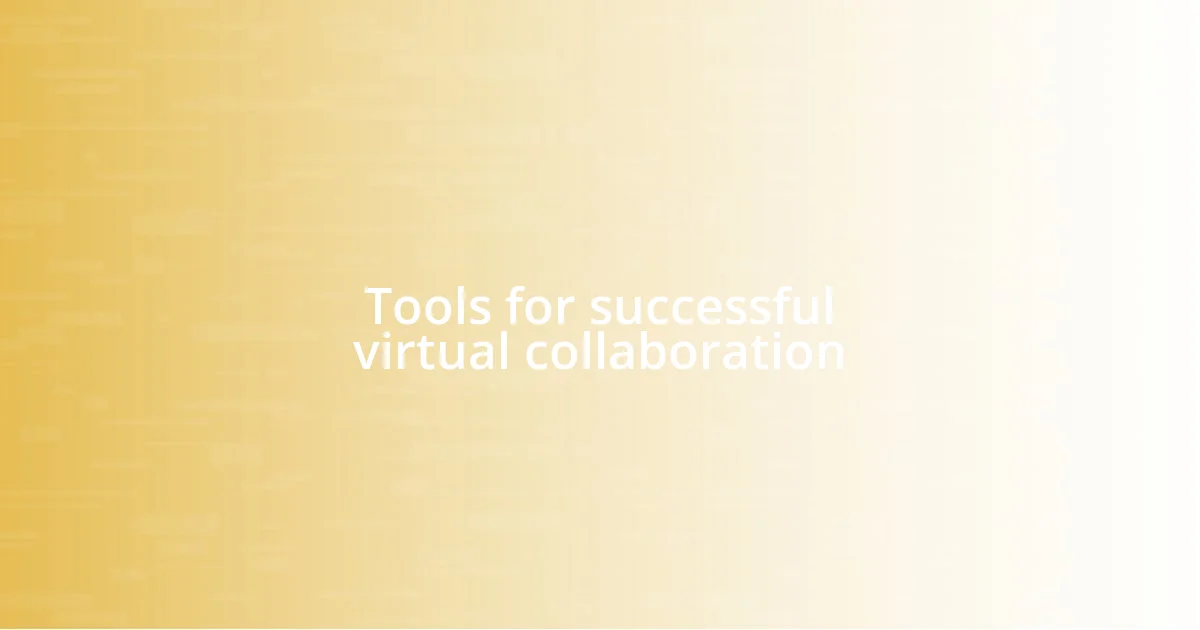
Tools for successful virtual collaboration
Virtual collaboration thrives on the right tools, and I’ve seen how these resources can shape team dynamics. For instance, my team heavily relied on platforms like Slack for messaging, but we soon discovered the power of video conferencing through Zoom. That shift transformed our interactions; seeing each other’s faces made discussions richer and communication more effective. I remember a particularly challenging project where brainstorming over video felt so much more engaging than merely typing messages.
Another crucial tool is project management software like Trello or Asana. It’s amazing how visualizing our tasks helped everyone stay aligned. There was a moment during a deadline crunch when I noticed some team members were overwhelmed. We turned to our project board, reassessed our priorities, and redistributed tasks. This transparency not only eased the stress but also cultivated a sense of ownership among us. I can’t emphasize enough how these simple tools can foster accountability and collaboration in a virtual space.
Finally, sharing documents in real-time using Google Workspace or Microsoft Teams has been a game-changer. During a virtual presentation, we were able to collaborate on a document in real-time, allowing instant feedback and suggestions. I felt a wave of excitement as ideas flowed seamlessly across screens. This level of collaboration reminded me that while we might be miles apart, with the right tools, we can create a cohesive and interactive team environment.
| Tool | Primary Function | Unique Feature |
|---|---|---|
| Slack | Messaging & Communication | Real-time updates with channels |
| Zoom | Video Conferencing | Breakout rooms for group discussions |
| Trello | Project Management | Visual task boards for easy tracking |
| Google Workspace | Document Collaboration | Real-time editing and comments |
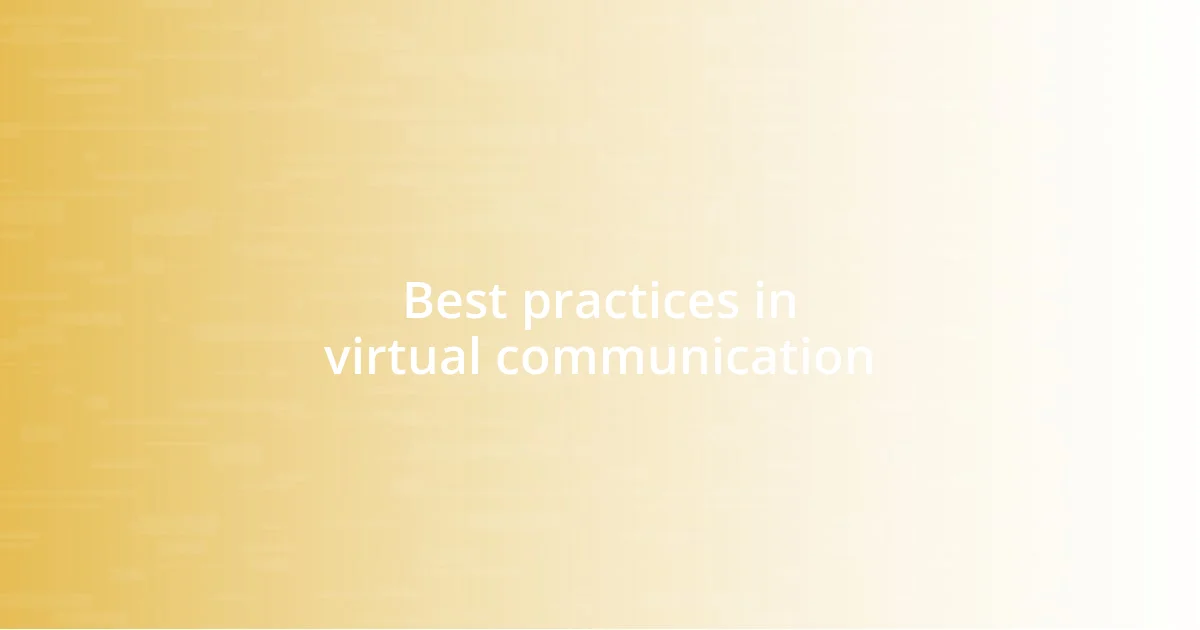
Best practices in virtual communication
Clear and effective communication is the backbone of any successful virtual team. From my perspective, establishing regular check-ins can make a significant difference. I recall a time when our team implemented weekly video calls, and it completely transformed our sense of connection. It felt like we were not just colleagues but part of a community. The opportunity to share personal updates and celebrate small wins together really boosted our morale and fostered a supportive atmosphere.
Listening actively is another best practice I’ve learned over the years. There was an instance during a brainstorming session where one team member hesitantly shared a novel idea. Instead of brushing it aside, we paused to explore it further. This willingness to engage created an environment where everyone felt empowered to speak up. How many times have you hesitated to voice a thought, fearing it might not be valued? I believe that encouraging open dialogue not only leads to innovative solutions but also cultivates trust among team members.
Lastly, embracing feedback, both giving and receiving, is crucial in virtual communication. I once had a peer who always sought my input on his presentations. At first, I thought it was just politeness, but later realized it was his way of ensuring we both grew. We can miss the nuances of body language in virtual settings, making it essential to be explicit in our feedback. How do you approach feedback in your team? Reflecting on this can enhance your interactions and strengthen relationships, making your team even more resilient in the face of challenges.

Strategies for building trust online
Building trust online is not just a matter of technology; it’s about connection. In my experience, sharing personal stories during meetings can significantly bridge the gap between team members. I remember when a teammate shared a touching tale about their childhood. It sparked laughter and empathy, making our interactions feel more human. How often do we miss those little moments that can truly deepen relationships in a virtual setting?
Consistency plays a crucial role as well. I once participated in a team that decided to uphold a ‘no work talk’ policy during the first few minutes of each meeting, focusing instead on personal check-ins. This practice not only established a rhythm but also helped us view each other as more than coworkers. I still think back to those sessions fondly, where we engaged in light-hearted banter. It reminded me of how nurturing rapport can transform the dynamic of the group.
Encouraging vulnerability is another vital strategy. I distinctly recall a moment when I felt comfortable enough to express my struggles with a project challenge. The support I received from my teammates was overwhelmingly positive. Their willingness to share their own struggles in return fostered a safe environment. Have you ever thought about how opening up can unlock deeper connections? It often leads to a team culture where trust flourishes and collaboration thrives.

Overcoming challenges in virtual teams
Navigating the challenges of virtual teamwork can feel daunting at times. In my journey, I’ve encountered moments when miscommunication led to frustration. I remember a project where incomplete messages caused a misalignment in our goals, leaving some team members confused and others feeling unappreciated. By instituting a shared project management tool, we found we could clearly outline tasks and deadlines, which transformed our workflow and reduced misunderstandings. Have you ever been in a situation where a simple tool could have saved time and energy?
Remote work can also breed a sense of isolation. I once led a team where members worked in different cities, and the absence of casual, in-person interactions became palpable. To counter this, we set up virtual coffee breaks, encouraging informal conversation. The result was remarkable; we not only built camaraderie but also fostered creativity. I often reminisce about those light-hearted discussions that sparked a flurry of new ideas. Have you experienced similar moments where casual chats led to significant breakthroughs?
Lastly, time zone differences can disrupt collaboration. Working with an international team often meant some members were waking up just as others were winding down. In one instance, we decided to rotate meeting times to ensure fairness and inclusivity. This simple change not only demonstrated respect for each other’s schedules but also prioritized everyone’s input. Have you found solutions to time zone challenges that brought your team closer together? Embracing flexibility can make a world of difference in maintaining cohesion among diverse teams.
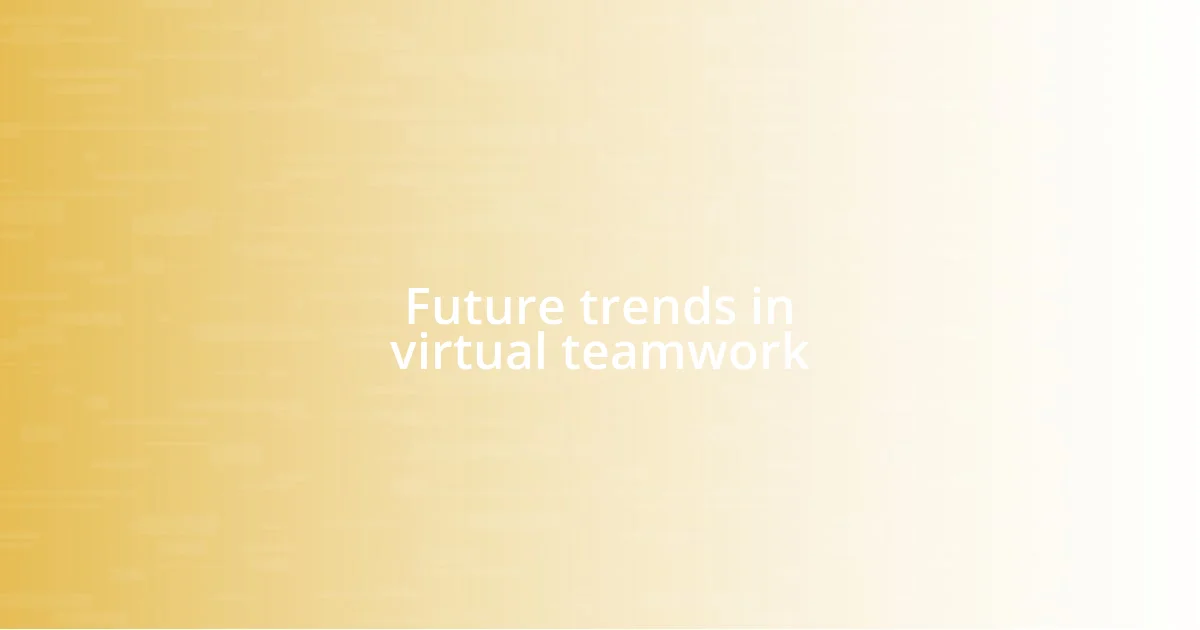
Future trends in virtual teamwork
The future of virtual teamwork is set to embrace artificial intelligence and automation in ways that will redefine our collaborative experiences. I remember when our team first integrated AI-driven tools to streamline task assignments. The efficiency we gained was impressive, allowing us to focus on the creative aspects of our projects. Have you considered how AI could take over mundane tasks, freeing your mind for more innovative solutions?
Another trend I see emerging is the enhanced focus on mental health and well-being in virtual settings. I participated in a workshop where we discussed mental wellness strategies tailored for remote teams. Sharing mindfulness practices and encouraging breaks during work hours made a world of difference in our overall morale. Have you ever thought about how simple gestures, like ensuring time for mental health, can strengthen your team’s bond?
Moreover, the future is likely to bring a more dynamic blend of synchronous and asynchronous communications. I recall a project where we experimented with asynchronous updates, allowing team members to contribute on their own schedules. This flexibility led to richer contributions, as people had time to reflect before replying. Have you tried mixing these approaches, and how did it change your team’s interaction? Balancing these methods could very well unlock the full potential of your remote collaboration.










